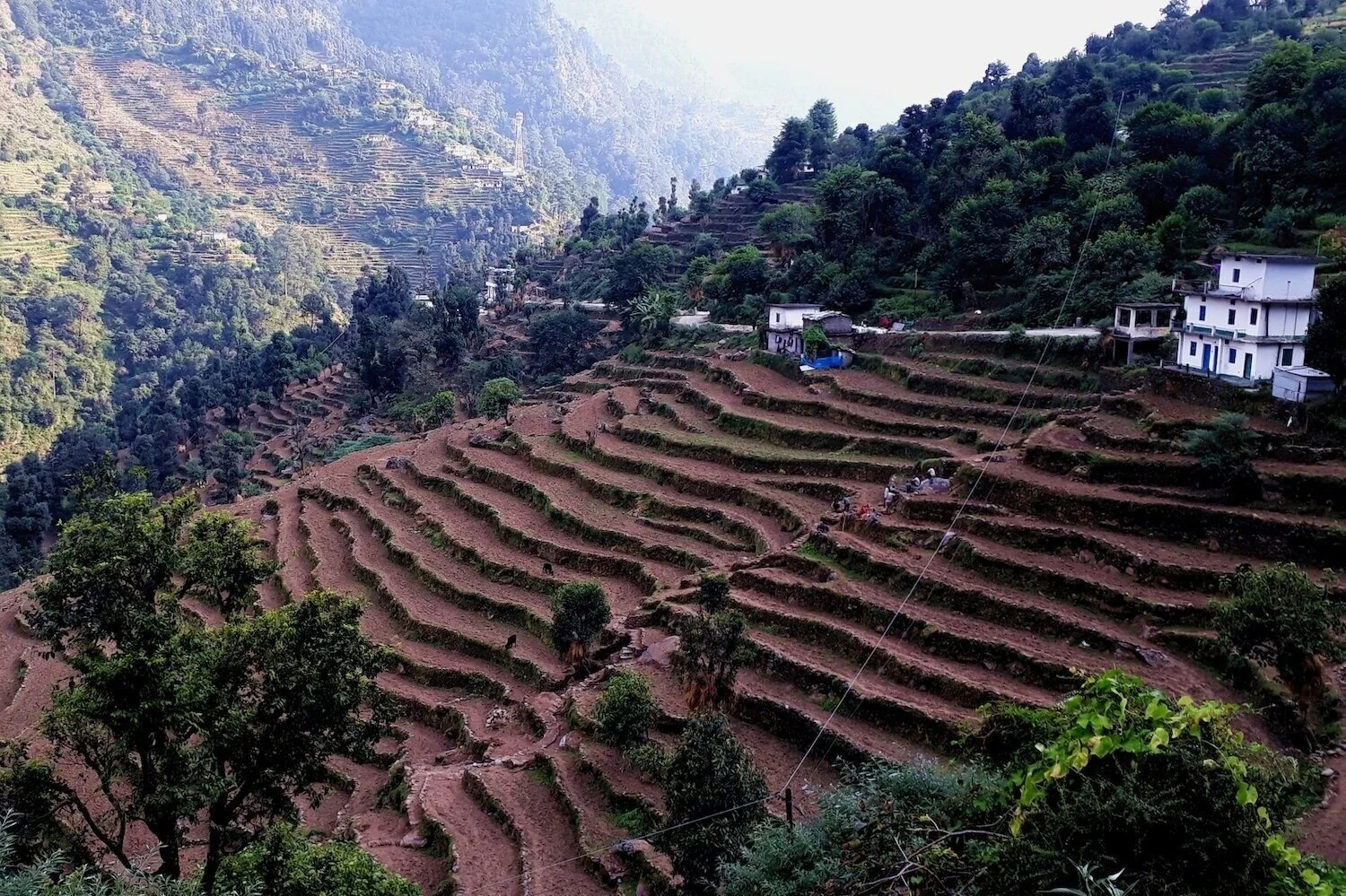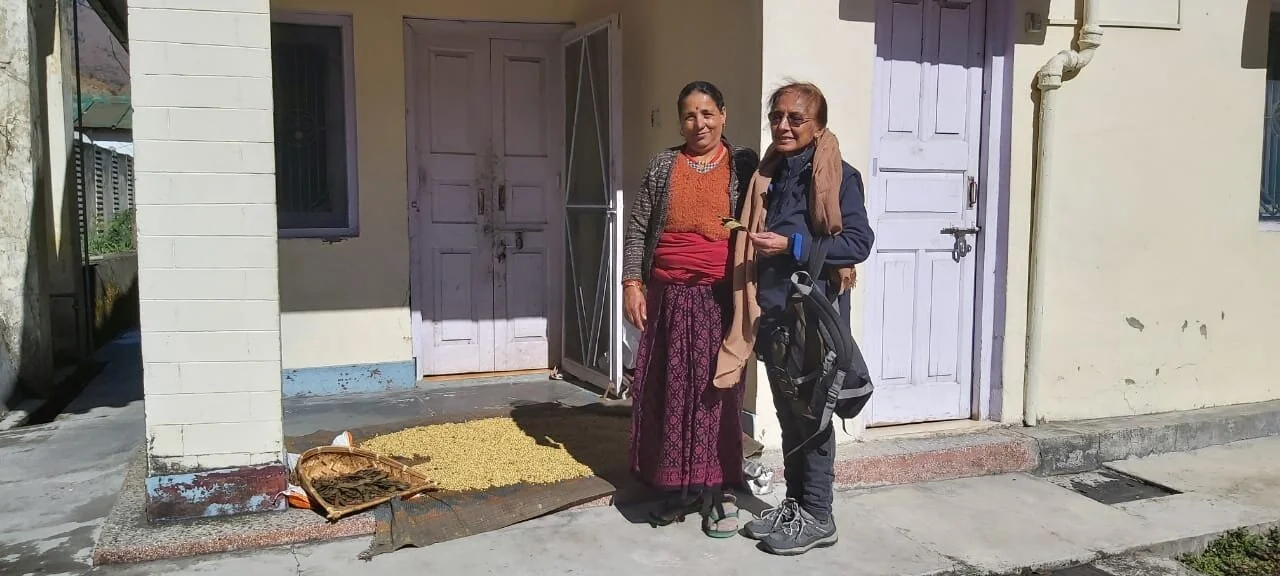In presenting vegetarian delights from Himalayan foothills, Veena Sharma seeks to promote ecological awareness
Veena Sharma, in March 2019 (Photo credit: Christine Lhande)
Thoughtfox reached out earlier in November to Veena Sharma, to talk to her about her new book, Vegetarian Cuisine from the Himalayan Foothills (Niyogi Books, 2020). Ms. Sharma once headed the Swahili Service of the External Services Division of All India Radio; she has published several research-based socio-cultural accounts, and was the Founder Chairperson of the Prajna Foundation for Cultural Interaction and Studies. She was kind enough to provide to us a free copy of her book in the portable document format (pdf).
On behalf of Thoughtfox, this interview was conducted via Google Messenger and Gmail by Piyush Mathur. With the consent of Ms. Sharma, the interview transcript has been edited at places for clarity and grammatical consistency.
Mathur: It has been very close to a decade since I met you in Shimla, Himachal Pradesh. Since then there have been a few times when I was lucky enough to have received your hospitality—and with it the foods that you had cooked for me and other guests. While always impressed with how well you hosted your guests, I also always left your house richer thanks to your insights into all manner of things from around the world. Given your pluralistic and cosmopolitan background, precisely what made you decide to work on this particular book at this point in time?
Sharma: Thank you Piyush. Yes, I also remember, nostalgically, our time in Shimla at the Indian Institute of Advanced Study. After that work this book must seem a little strange to you—but then, as humans we have so many facets. Actually, as you remember well, I had always been interested in the therapeutic and regenerative value of food. Other than its sensually pleasing quality, food is a panacea for many ailments—be they physical or even mental. Consumption of food is a very holistic act as other than giving us satisfaction at a very fundamental level, it connects us to the earth and our environment and to ourselves! When I moved to Rishikesh, one of the things that caught my attention was the variety of herbs and spices—and several different legumes and vegetables that were abundantly available.
Even so, this book had a funny origin. Sometime back I was scanning some old files, and I came upon one—written for a grandchild—on herbs and kitchen friends. This file had been sitting there for a very long time. On the spur of the moment, like the dropping of a coin into a slot, a thought trickled into the brain that I should not discard it but share it with a larger audience who might be interested in the subject. This was all the more feasible now —when I had the advantage of being in a place where there was a plethora of ingredients, many of which I did not know and could explore.
Mathur: The book is beautifully put together—and I was really impressed with the photographs it contains…
Sharma: Thank you! Well, as I started thinking about this theme I approached Niyogi Books—whose publications I liked very much—because of the attention they give to their books. They immediately agreed to my proposal—which, to me, had a lot to do with spreading awareness about food, environment, and biodiversity. As we progressed, my young friend Nandita offered to embellish the book with her sensitive photography; she also helped in measuring and quantifying ingredients—a process necessary for the presentation of recipes in a book form!
Of course many other persons, directly or indirectly, also moved in and out of our journey through our book. So, in some ways, one can say, their inadvertent contributions made me think of exploring and creating in directions that I may not have thought of before.
Mathur: From your answer, it appears that your internal migration—from New Delhi to Rishikesh—ushered in a larger change in your life; and it made you take a second look at food and cooking: phenomena that you had otherwise long mastered personally. Thoughtfox readers would be most interested to know how this personal relocation twined itself into your renewed interest in food matters.
Sharma: Actually, I had been coming to Rishikesh very frequently since my first visit in March 1980. You might remember that the Sivananda Ashrama, of which I have been a long-time devotee, was a great centre of attraction for me. There is something so auspicious about the terrain also. Coming here to settle down, my attention was again drawn to the terraced hills, fed by mountain streams that bring minerals and other nutrients from the upper mountainous regions. Not to forget that this is also the land where the holy Ganga—with its very special waters—originates. Traditionally the crops here would have been fed, to some extent, by the tributaries of the Ganga. So, imagine the quality of their waters!
We have to recognize that a terrain and its produce are not divorced from each other. Having been interested in the recuperative qualities of food, I felt that the food grown in these areas had a special quality. Traditionally, the people of these hills have been very sturdy (though that is changing now).
Mathur: You know, what has personally interested me about your book's contribution is that it showcases the Himalayan foothills’ cuisines—which have not been brought to the notice of outsiders. From and within India, we normally hear and read about the Gujarati plate, the Rajasthani plate, South Indian foods, Punjabi foods, and Bengali sweets—but not about foods and cuisines from this specific region. So, did this relative culinary obscurity of the region challenge—and inspire—you to take up this project? Or would you say that I am wrong in assuming that these regional foods have been generally obscure to the outsiders—unlike those other cuisines that I have mentioned?
Terraced farming in Garhwal (Uttarakhand), 2019 (Photo credit: Nandita Singh)
Sharma: No, you are right. The cuisine of the area has remained concentrated in the pockets here or perhaps came to be seen more as a rural form of food preparation; so it did not get picked up by outsiders. I would say that the locals are equally to blame for this lack of spreading knowledge about their food. Not only have they not popularised their own foods, they themselves have been moving away from it as they allowed packaged food cultures from outside to make inroads here. And as the grains and other produce did not get popularized, they probably felt their land wasn't giving back much in return; so they started putting their aesthetically and culinarily beautiful fields to other uses.
The terribly saddening and environmentally disastrous impact on the ecology can be seen in the land fast giving way to ugly concrete structures, built with no sensitivity of the topography. Packaged foods, with no or little nutritional content, are not only affecting individual health but have led to a surfeit of plastics and other materials that are choking the streams and the mountain flora. That is why we can claim that popularising and reviving the grains, herbs and other produce from here could impact life on many levels.
We find some local food—such as kulath ke paratha, kulath daal, or mandua ki roti—in some dhabas; but for some reason it did not spread much—even though there are people like me who are now getting interested in the grains, legumes and herbs that had started becoming rare. You would have noticed expensive packets of these very grains sold under the label 'Ancient Grains'! In this book the effort is to use these highly nutritious ingredients in ways that would suit the urban table. The ingredients used in this book are from local vendors who cater to the local populations. The vendors are also now becoming aware that there are 'outsiders' like us who wish to procure these.
If the authorities were to take interest they could help demarcate certain areas for 'organic' farming. 'Organic' is now a much touted word for business purposes. But traditionally that is what people have been eating. If these grains were to be popularised the farmers could continue to use their traditional techniques. For, they know their land—its gradient, its direction, and what would grow on it and where.
So, you can say, that there were many concerns that went into the making of this book.
Mathur: You are very correct in your observation there. After years of residing in Shimla, for instance, I was able to find just one eatery—the Cafe Under Tree, right close to the Jakhu temple—that offers Himachali food (and they had an excellent cook when I chanced upon the place in 2018). Other than that, Shimla has nothing local or regional to offer in the name of food! You start out your book by calling it "a homegrown cookbook." That's a rather unusual characterization of a cookbook. Could you please unpack that a little bit for our readers?
Sharma: What I mean is that the recipes given therein are the result of an interaction between our ‘homegrown’ creativity and experimentation with local produce. It is not the work of a trained Chef. It is a replication of what is put out on our table. Besides, as I said earlier, consciously or unconsciously, the ideas gained from many sources made their way into the book even as they were turned into some forms that were very different to the original ideas.
But the book does take into account the nutritional aspects of the dishes. And that had much to do with the local produce as also with our ancient sciences of Ayurveda and Yoga, which look upon food as a major ingredient of our personalities. So, you may say it’s not just a cookbook but a book about awareness; a book that aims to evoke in the reader a sense of adventure in the realm of culinary forest! The recipes given can be turned and twisted according to one’s own preferences.
It was a fun-filled exercise. Many a time I would prepare something, completely forgetting about the requirement to measure and quantify (as, by nature, I do not measure ingredients; the quantities just happen), and then Nandita and I would have to go over the process once again. There were times when I would have prepared a dish—and by the time Nandita was ready and available to ‘shoot’ it, the dish would be gone!
Mathur: When you began focusing on this region from the perspective of its foods and cuisines, there must have been some foods that truly surprised you: maybe because you had not even heard of them before—despite your vast experiences; or maybe you would not have even imagined that their ingredients could be mixed up in the way they are; or maybe you found the cooking behind them to be too peculiar or unique. Would you like to describe some of these foods—their ingredients, perhaps a little bit of their cooking process—for our readers?
Sharma: Yes, there were some foods and several spices that I had not previously come across or used. Some of those spices were jakhiya, chora, bhangjeera, and faran: the latter two grow at higher altitudes and one gets them only during certain seasons. Jakhiya is a smaller-than-mustard-seed spice which is used like we generally use jeera. But jakhiya has a crisp, crunchy flavour that adds zest to the dish. I had first come across it some years ago in Dilli Haat and was a bit sceptical about using it, for even the name in my mind was a bit suspect. Coming here I find myself using it liberally with good effect. The vendor is also happy to explain how these are used by the locals.
There are many greens, too. For example, ‘lingdaa’—for some reason called 'fiddlehead greens' in English—caught my attention when I saw a local woman sitting with a coiled up stem-like thing that eventually opens up into a kind of fern. It grows in swamps and is difficult to harvest; and is generally available during the monsoons. There are many leafy greens like chaulai (amaranth), rai, soya, and several others available at different times of the year. These would be found in other parts of India also; but here there is a plethora of different varieties of greens. Pahadi palak, for example, is smaller-leafed and tastier than the large-leafed palak [of the plains].
Then there are hemp seeds—which are used by the locals in chutneys or pakoras—as they provide a nice crunch. The vendor I buy it from calls it 'brain food'! There are also many seeds—samak ke chawal, jhangora, and many such. All of these are gluten free, so [they are] easy on the digestive system even as many of them provide high-quality protein.
As for local usage, I found it interesting that they grind many of the daals—like kulath—and then cook them. I have used local daals—like kulath, chora, navarangi daal—somewhat differently, after finding out how the locals use them. The different gradients and direction of the small farms terraced on the hills allows a large variety of legumes to grow. For example, I had never seen so many varieties of rajma: black, pink, brown, red, variegated, what have you.
I think it is time we started looking back into these very healthful ingredients.
In Bhatwadi village of Tehri Garhwal, Uttarakhand, a local woman dries bhatt daal and kedar patti out in the sun; the woman is pictured standing next to Veena Sharma in this November 2020 photo. (Photo credit: Srimurti)
Mathur: Well, your detailed response was quite a lapful—of information and delight! But in one sentence, how would you like to characterize your book for the readers of this interview?
Sharma: Besides being a cookbook highlighting cuisines from the Himalayan foothills, this small book is an invitation to explore one’s environment and one’s own specific nutritional requirements via some recipes; it is about spreading ecological awareness via healthy local foods. One may say that if we eat well, not only do we raise a crop of sturdy-in-mind-and-body individuals but we also protect our mountains and streams from mounds of plastic and other garbage generated by new fangled packaged foods. We also save the aesthetic and cultural beauty of these mountains and hills.
Mathur: Ms. Sharma, it was a pleasure interviewing you for Thoughtfox! Your book would likely make a lovely Christmas or New Year gift for many eco-conscious foodies. We wish you all the best with your future endeavours.
Sharma: It was good talking to you, Piyush. Thank you.
Piyush Mathur is the author of Technological forms and ecological communication: a theoretical heuristic (Lexington Books, 2017).
If you wish to contact Thoughtfox regarding this interview, then please send a message using this form. You may also use the space below to post any comments.





